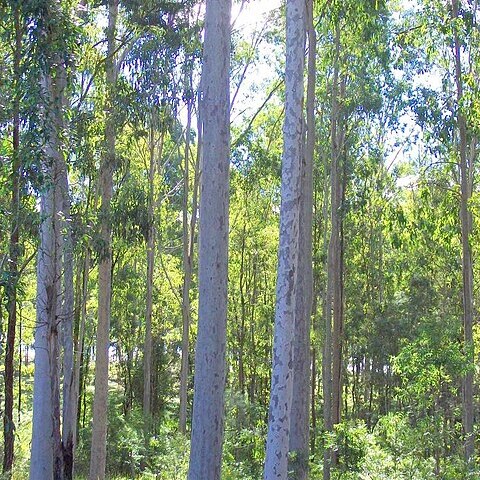Tree to 25 m tall. Forming a lignotuber. Bark smooth, spotted grey, pink, cream, yellow, orange and salmon, sometimes becoming granular with age.Branchlets smooth (glabrous); sometimes with oil ducts visible in the pithJuvenile growth (coppice or field seedlings to 50 cm): stem rounded or square in cross-section; juvenile leaves opposite for a few pairs, petiolate, soon alternate, petiolate, broadly ovate to lanceolate, 8–25 cm long, 4–10 cm wide, base of lower leaves peltate becoming rounded to tapering higher up stem, green; stems, petioles and both surfaces of lamina scabrid for the first few nodes then smooth. Adult leaves alternate, petiole 1.5–3 cm long; blade lanceolate, 11–28 cm long, 2.2–4.5 cm wide, flat or undulate (especially near the margin), base tapering to petiole, concolorous, glossy, green, side-veins greater than 45° to midrib, densely to very densely reticulate, intramarginal vein parallel to and remote from margin, oil glands mostly island. Inflorescence axillary compound, peduncles 0.5–1 cm long, buds 3 per umbel, pedicels 0.2–0.7 cm. Mature buds ovoid to obovoid to pyriform, 1.2–1.3 cm long, 0.6–0.8 cm wide, often weakly 2-ridged at base of hypanthium, green, yellow or creamy, outer operculum shed at or just before flowering time, clearly separate from inner operculum, operculum conical and beaked, stamens inflexed, anthers cuboid to oblong, versatile, dorsifixed, dehiscing by longitudinal slits (non-confluent), style long, stigma blunt or tapered, locules 3 or 4, the placentae each with usually 5 vertical ovule rows. Flowers white or lemon. Fruit pedicellate (pedicels 0.2–0.5 cm long), barrel-shaped to urceolate, 0.9–1.5(2) cm long, 0.9–1.6 cm wide, disc descending, valves 3 or 4, enclosed. Seeds dark glossy red-brown, 3–4.5 mm long, flattened and with shallow dorsal keel (boat-shaped), sometimes pointed at one end, dorsal surface smooth and usually cracked, not winged, hilum ventral. Cultivated seedlings (measured at ca node 10): cotyledons reniform to orbicular; stems rounded in cross-section except near apex where they are square, scabrid especially on lower internodes; leaves always petiolate, peltate from ca node 5 to 8 (rarely to node 11), opposite for 5 or 6 nodes then becoming alternate, ovate to broadly lanceolate, 12–20 cm long, 5.5–8 cm wide, base peltate and/or lobed only at lowest nodes becoming rounded to tapering up stem, apex pointed (drip-tip), slightly discolorous, glossy, green, newly formed leaves at growing tip very glossy and claret-coloured. Leaves scabrid on underside and petiole until ca node 8.
More
Tree to 30 m. Bark grey, cream or pink-grey, usually mottled. Juvenile leaves ovate, sparsely setose, sometimes peltate. Adult leaves lanceolate to broadly lanceolate, sometimes falcate; lamina 16–28 cm long, 2.7–4.5 cm wide; lateral veins prominent, at 35°–50°; intramarginal vein up to 1 mm from margin; petiole flattened or angular, 10–25 mm long. Peduncle angular, 3–6 mm long; pedicels 3–4 mm long. Buds ovoid; operculum hemispherical, apiculate or conical, 4–6 mm long and wide; hypanthium hemispherical, 6–9 mm long, 4–6 mm wide. Fruits subglobular or suburceolate, 10–20 mm long, 10–16 mm wide.


